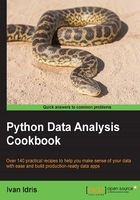
Seeding random number generators and NumPy print options
For reproducible data analysis, we should prefer deterministic algorithms. Some algorithms use random numbers, but in practice we rarely use perfectly random numbers. The algorithms provided in numpy.random allow us to specify a seed value. For reproducibility, it is important to always provide a seed value but it is easy to forget. A utility function in sklearn.utils provides a solution for this issue.
NumPy has a set_printoptions() function, which controls how NumPy prints arrays. Obviously, printing should not influence the quality of your analysis too much. However, readability is important if you want people to understand and reproduce your results.
Getting ready
Install NumPy using the instructions in the Learning to log for robust error checking recipe. We will need scikit-learn, so have a look at http://scikit-learn.org/dev/install.html (retrieved July 2015). I have installed scikit-learn 0.16.1 via Anaconda.
How to do it...
The code for this example is in the configure_numpy.py file in this book's code bundle:
from sklearn.utils import check_random_state import numpy as np from dautil import options from dautil import log_api random_state = check_random_state(42) a = random_state.randn(5) random_state = check_random_state(42) b = random_state.randn(5) np.testing.assert_array_equal(a, b) printer = log_api.Printer() printer.print("Default options", np.get_printoptions()) pi_array = np.pi * np.ones(30) options.set_np_options() print(pi_array) # Reset options.reset_np_options() print(pi_array)
The highlighted lines show how to get a NumPy RandomState object with 42 as the seed. In this example, the arrays a and b are equal, because we used the same seed and the same procedure to draw the numbers. The second part of the preceding program uses the following functions I defined in options.py:
def set_np_options():
np.set_printoptions(precision=4, threshold=5,
linewidth=65)
def reset_np_options():
np.set_printoptions(precision=8, threshold=1000,
linewidth=75)
Here's the output after setting the options:
[ 3.1416 3.1416 3.1416 ..., 3.1416 3.1416 3.1416]
As you can see, NumPy replaces some of the values with an ellipsis and it shows only four digits after the decimal sign. The NumPy defaults are as follows:
'Default options' {'edgeitems': 3, 'formatter': None, 'infstr': 'inf', 'linewidth': 75, 'nanstr': 'nan', 'precision': 8, 'suppress': False, 'threshold': 1000}
See also
- The scikit-learn documentation at http://scikit-learn.org/stable/developers/utilities.html (retrieved July 2015)
- The NumPy
set_printoptions()documentation at http://docs.scipy.org/doc/numpy/reference/generated/numpy.set_printoptions.html (retrieved July 2015) - The NumPy
RandomStatedocumentation at http://docs.scipy.org/doc/numpy/reference/generated/numpy.random.RandomState.html (retrieved July 2015)